Identification of Target Genes and Transcription Factors in Mice with LMNA-Related Dilated Cardiomyopathy by Integrated Bioinformatic Analyses
- PMID: 32581210
- PMCID: PMC7313426
- DOI: 10.12659/MSM.924576
Identification of Target Genes and Transcription Factors in Mice with LMNA-Related Dilated Cardiomyopathy by Integrated Bioinformatic Analyses
Abstract
BACKGROUND Dilated cardiomyopathy (DCM), which is characterized by enlarged ventricular dimensions and systolic dysfunction, is the most common type of cardiomyopathy. Mutations in the LMNA gene are reported in approximately 10% of familial DCM cases. However, the mechanism of LMNA mutations in human DCM remains unclear. MATERIAL AND METHODS We used the GSE36502 and GSE123916 datasets to obtain gene expression profiles from LMNA-related DCM mice and to identify differentially expressed genes (DEGs). Crucial function and pathway enrichment analyses of DEGs were performed. Protein-protein interaction (PPI) network analysis was carried out to identify the top 10 hub genes, which were validated using reverse transcription-polymerase chain reaction (RT-PCR) to find target genes. Weighted gene co-expression network analysis (WGCNA) was used to explore the module relevant to external traits of LMNA-related DCM mice. Transcription factors (TFs) for the selected genes were analyzed using NetworkAnalyst. RESULTS A total of 156 common DEGs (co-DEGs) were identified, including 80 up-regulated and 76 down-regulated genes. The enriched biological functions and pathways were oxidative stress, regulation of apoptosis, regulation of fibrosis, and MAPK pathways. Five target genes (Timp1, Hmox1, Spp1, Atf3, and Adipoq) were verified after RT-PCR. Most co-DEGs were discovered to be related to the development of external traits. Three TFs (ELF1, ETS1, and NRF1) showed close interactions with the hub genes. CONCLUSIONS Our study used integrated bioinformatic analyses and revealed some important genes in mice with LMNA-related DCM, which could provide novel insights into the mechanism underlying human LMNA-related DCM.
Conflict of interest statement
None.
Figures
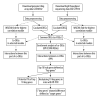


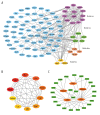
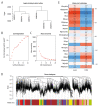
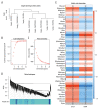

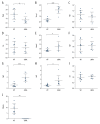
Similar articles
-
DNA Damage Response/TP53 Pathway Is Activated and Contributes to the Pathogenesis of Dilated Cardiomyopathy Associated With LMNA (Lamin A/C) Mutations.Circ Res. 2019 Mar 15;124(6):856-873. doi: 10.1161/CIRCRESAHA.118.314238. Circ Res. 2019. PMID: 30696354 Free PMC article.
-
Integrated microarray analysis to identify potential biomarkers and therapeutic targets in dilated cardiomyopathy.Mol Med Rep. 2020 Aug;22(2):915-925. doi: 10.3892/mmr.2020.11145. Epub 2020 May 14. Mol Med Rep. 2020. PMID: 32626989 Free PMC article.
-
Exploring the predictive values of SERP4 and FRZB in dilated cardiomyopathy based on an integrated analysis.BMC Cardiovasc Disord. 2024 Oct 18;24(1):577. doi: 10.1186/s12872-024-04255-6. BMC Cardiovasc Disord. 2024. PMID: 39425025 Free PMC article.
-
Lamin A/C mutations in dilated cardiomyopathy.Cardiol J. 2014;21(4):331-42. doi: 10.5603/CJ.a2014.0037. Epub 2014 May 20. Cardiol J. 2014. PMID: 24846508 Review.
-
'State-of-the-heart' of cardiac laminopathies.Curr Opin Cardiol. 2013 May;28(3):297-304. doi: 10.1097/HCO.0b013e32835f0c79. Curr Opin Cardiol. 2013. PMID: 23455585 Review.
Cited by
-
Characterization and natural history of patients with LMNA-related dilated cardiomyopathy in the phase 3 REALM-DCM trial.ESC Heart Fail. 2024 Dec;11(6):4201-4208. doi: 10.1002/ehf2.14955. Epub 2024 Aug 15. ESC Heart Fail. 2024. PMID: 39145700 Free PMC article. Clinical Trial.
References
-
- Hershberger RE, Morales A. LMNA-related dilated cardiomyopathy. In: Adam MP, Ardinger HH, Pagon RA, et al., editors. GeneReviews®. Seattle (WA): University of Washington, Seattle; 1993. - PubMed
-
- Weintraub RG, Semsarian C, Macdonald P. Dilated cardiomyopathy. Lancet. 2017;390:400–14. - PubMed
-
- Arbustini E, Pilotto A, Repetto A, et al. Autosomal dominant dilated cardiomyopathy with atrioventricular block: A lamin A/C defect-related disease. J Am Coll Cardiol. 2002;39:981–90. - PubMed
MeSH terms
Substances
Supplementary concepts
LinkOut - more resources
Full Text Sources
Research Materials
Miscellaneous

